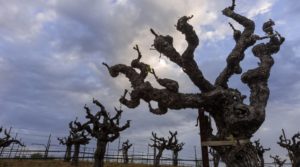
The national authorities responsible for such things have strict rules about what can be said on a wine label. But there’s always room for creativity, and it can be hard to know where legally sanctioned terms leave off and marketing begins. In the latter category are references to the age of vines that are the source of the grapes used to make what’s in the bottle. You’ll see vieilles vignes on French wine labels, alte Reben on German, and vecchie viti on bottles from Italy. The phrases all mean “old vines.” But just how old is old — 50 years? 75? 100? — and why we should care?
The first question is easy to dispense with: The term has no foundation in wine law. Old means pretty much whatever the winemaker wants it to mean. Per point two, conventional wisdom has it that more mature vines enjoy an advantage over younger ones in part because they have more well developed root systems. It’s true that vines with roots that reach deeply into the earth can tap reserves of moisture that in a hot, dry vintage would not be available to less mature plants. (Note that in much of Europe, the irrigation of wine vines is not permitted.)
But while this may have something to do with survival, it’s not clear that vines with more highly developed root systems necessarily make wine with more depth or richness or which can be shown to be consistently better in any way. However, it’s understood that vines can make excellent wine in their adolescent years. The 1973 Stag’s Leap Wine Cellars Napa Valley Cabernet that bested1970 Château Mouton Rothschild and Château Haut Brion in the famous Judgment of Paris tasting in 1976 (and put California wine on the map) was made from vines only three years old — in vine age, mere teens.
There is some thought that vines in their first bearing years are not as vigorous as they will become and so have a better balance of fruit to leaf. But there’s also the fact that as vines reach middle age (30 or 40 years), both fruit and canopy diminish. In this way, mature vines may eventually achieve the same degree of balance as their youthful counterparts. It’s also possible that the declining yields of fruit that characterize older plants also figure in, as a dwindling number of grapes enjoy a bigger share of the energy mature roots, trunk and canes pump into them. Superannuated vines are always less productive (meaning, they yield less fruit), and for some this fact alone is sufficient to demonstrate their superiority. It’s also the case that many winemakers reserve the fruit from their grayest vines for their prestige cuvées, while younger ones supply their entry-level offerings. This is perhaps the strongest empirical evidence we have for legitimizing a privileged status for elder vineyards.
There’s one more factor to consider. Because winemakers who make reserve or old vine cuvées can generally charge a bit more for them, it makes it worth their while to put in some extra effort. So, they may find ways to lower the yield even further, pick a bit later (to boost ripeness), or treat the wine to some time in new oak barrels. All of which tend to lend drama to the finished product — making it difficult to tease out the contribution those senior vines are actually making.
So long as there are no agreed upon standards for what constitutes an “old vine,” no rules about how what percentage of old vine juice must be present to merit the description, and no consensus on precisely how older vines might make wine of better quality, it’s probably best to take all such claims with a pinch of salt . . . the older the better.
-Stephen Meuse
Taste, talk, and learn about wine this week in the FKC wine corner . . .
THURSDAY, JULY 18 3-6 PM – MIDSUMMER NIGHT’S MEME
2018 Gaintza, Getariako Txakolina, $22.95
2017 Di Filippo, Umbria Grechetto, $25.95
2017 Fabien Jouves Cahors “Les Escures’” $23.95
FRIDAY, JULY 19 3-6 PM – FRESH CAUGHT
2016 Giovanni Menti, Gambellara“Riva Arsiglia, $23.95
2017 Jean Baptiste Senat, Minervois “La Nine,” $25.95
2017 Vini Conestabile della Staffa, Umbria “Conestabile Rosso,” $24.95